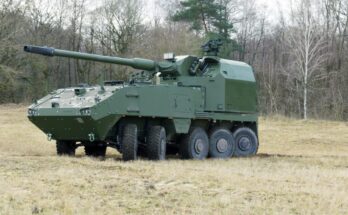
The race was too close to call on election day, but former Vice President Joe Biden has unseated incumbent Donald Trump in the presidential election, multiple news outlets are reporting. The president has not formally conceded the election and has launched multiple legal challenges, while also voicing unsubstantiated claims about widespread voter fraud and a stolen election. A handful of Republicans have congratulated the president-elect, but much of the party has remained silent so that Trump’s legal strategy can play out. For the time being, the Biden team turns its eye toward its transition to the White House, and we take a look at what a new administration will mean for defense spending and the Pentagon as a whole.
One thing to remember is that the balance of power in the Senate has not been determined. As it stands, the Senate race is currently split at 48 seats for each party, including two independents that caucus with the Democrats. Two Georgia Senate races – one of which is a special election to replace a senator that resigned due to health concerns – have gone to run-off elections scheduled in January. Democrats would need to win both seats in Georgia to split the Senate at 50-50, which would give Vice President Kamala Harris the deciding vote in the event of a party-line tie. Winning both run-off elections will be an uphill battle for Democrats in a traditionally red state, meaning Republicans may hold onto the chamber.
A Republican-led Senate would limit the overall policy influence of a Biden administration, for example by requiring more centrist cabinet members, impacting judicial appointments, and controlling the Senate’s legislative agenda. Regardless of the Senate outcome, however, most legislation will still require some level of Republican support, including annual appropriations bills.
When it comes to the defense budget, Biden has said that he does not anticipate large defense cuts, but the topline may decline slightly. While he will face pressure from his party’s progressive wing to enact steeper defense cuts to pay for domestic priorities, that push will be counterbalanced by needing to get appropriations bills through the Senate. House Armed Services Committee Chairman Rep. Adam Smith (D-Wash.) also doesn’t anticipate significant cuts, saying he envisions a defense budget of between $720 billion and $740 billion under a Biden administration, compared to the $740.5 billion FY21 request and the Trump administration’s projected budget of $759 billion in FY22. The White House’s FY22 projection reflects growth of about 2.5 percent, with the outyear budget remaining flat after adjusting for inflation. A $720 billion topline would reflect a cut of about 2.8 percent compared to the FY21 request, and would be about 5.1 percent less than the current FY22 projection. These figures represent the broader national security category that includes some defense programs outside of the Pentagon.
It’s important to remember that the White House’s flat budget projections were drafted before the pandemic hit. Since then, the economy has stalled and stimulus bills have added trillions of dollars to the deficit. Even under a second Trump administration, a flat defense budget would have been a best-case scenario, and a small decline would have been possible. COVID-19 cases are now climbing ever higher, which will further constrain the economy over the coming months. With a vaccine still on the horizon, the timeline of a full economic recovery remains unclear. So while defense leaders have consistently called for 3-5 percent real annual budget growth, any administration would be hard-pressed to reach that target in today’s environment. In fact, the true extent of the pandemic’s impact on defense outlays won’t be known for some time. Near-term efforts will focus on protecting critical defense supply chains, and pandemic-related budget cuts may be delayed by a year or two.
The incoming administration will be tasked with drafting a new defense strategy to replace the 2018 document. The U.S. focus on the Pacific region won’t change. That shift began under the Obama administration, and will proceed as China continues to grow as an economic and military power. In reality, many of the core tenets of the current defense strategy will remain in place under a Biden administration. The current defense strategy emphasizes the desire for the U.S. to rely on allies and partners, and to pursue a path of transparency and non-aggression with China. Despite Trump’s often bellicose approach to foreign policy. Representative Smith has expressed concerns that the current administration’s focus on military confrontation with China and Russia are a “recipe for a very dangerous and unnecessary Cold War.” A new defense strategy won’t reverse the need to prepare for potential high-end conflicts, so there will likely be more nuanced changes in how the strategy is phrased and presented as a whole. A revamped strategy would also double down on building relationships abroad and place a greater emphasis on soft power.
Biden supports a smaller footprint in the Middle East, but he stops short of promising a full withdrawal, due to the complicated nature of the situation on the ground. Trump has been trying to fulfill a campaign promise to bring troops home, but operational realities have slowed those efforts. Biden is open to a small U.S. presence in troubled areas, with a focus on special operations forces rather than large ground contingents. He would also review other troop movements abroad, such as Trump’s decision to remove thousands of U.S. personnel from Germany. Trump claimed the move was in response to Germany failing to spend enough money on defense. The president has frequently chastised NATO countries for failing to meet their obligation to spend 2 percent of GDP on defense, and has developed a contentious relationship with a number of NATO leaders. Biden aims to repair some of those relationships, but it remains to be seen how hard he will push NATO to reach the 2 percent spending benchmark.
One area that could see a substantial change is that of nuclear weapons. Biden has said in the past that he wants to move closer to a world without nuclear weapons. While that stance doesn’t mean he is about to cut one of the legs of the nuclear triad, there will be a smaller reliance on nuclear weapons as part of the broader defense strategy, which could result in less overall funding for nuclear modernization. Two new programs that surfaced in the 2018 nuclear posture review may also be impacted: a low-yield nuclear warhead recently fielded on submarine-launched ballistic missiles, and a submarine-launched nuclear cruise missile.
Biden supports a five-year extension to the New START nuclear arms agreement with Russia, which is due to expire in February 2021. Washington and Moscow have been negotiating a possible extension, but an agreement has not been finalized. The Trump administration has already walked away from other arms control agreements, including the Intermediate-Range Nuclear Forces (INF) Treaty, which banned ground-launched ballistic and cruise missiles with ranges of between 500 and 5,500 kilometers, and the Open Skies Treaty, which allowed unarmed observation flights over the territories of treaty members. The Air Force was planning to replace two OC-135B aircraft used for Open Skies flights, while the INF withdrawal enabled the Army to launch a new mid-range missile program that would fill the gap between its future Precision Strike Missile and longer-range hypersonic missiles. The Army recently selected the Tomahawk and SM-6 to meet its ground-launched mid-range missile requirement.
Some parts of the defense budget will see an increase under a Biden administration. The president-elect has said that the U.S. needs to focus more on unmanned capabilities and cyber and information technology. He also generally supports diverting money from legacy systems in order to support newer advanced capabilities. The Pentagon has already been trying to retire legacy platforms for this purpose, but this strategy faces resistance from lawmakers that are hesitant to divest systems that have life remaining or that benefit their constituencies. Biden has also promised to better equip the National Guard.
There are questions about the Navy’s recently unveiled Battle Force 2045 plan, which envisions a future fleet of well over 500 manned and unmanned ships. Last month, Defense Secretary Mark Esper summarized some of the details of Battle Force 2045, but noted that the exact size of the fleet was still being determined. Representative Smith has said he would rather focus on developing specific capabilities than on ship numbers. There are also affordability concerns about the plan, particularly because some government watchdogs believe the Navy is already underestimating the cost of its future ships. While the actual scope of the future fleet remains to be seen, certain aspects of Battle Force 2045 will likely persist under a Biden administration, like the need for more attack submarines, a renewed focus on small surface combatants, and developing more unmanned capabilities.
The new administration will also address Buy American policies. A provision in the House version of the FY21 defense authorization bill would require 75 percent of DoD components for acquisition programs to be sourced domestically by October 2021, and 100 percent by 2026. The provision received pushback from Republican and Democratic leadership and the White House, as well as allies concerned about the loss of industrial partnerships and access to the U.S. market. While this provision doesn’t have enough support to be signed into law, the new administration is expected to push for increased domestic sourcing of equipment for Pentagon acquisition programs. There will be a particular effort to reduce reliance on China for materials within the supply chain. Arms exports may also be impacted. The Trump White House pushed to increase weapons sales abroad, but a Democratic administration would be more likely to restrict sales to certain customers, like Saudi Arabia, over concerns about human rights or other issues.
Shaun's deep-rooted interest in military equipment continues in his role as a senior defense analyst with a focus on the United States. He played an integral role in the development of Forecast International's U.S. Defense Budget Forecast, an interactive online product that tracks Pentagon acquisition programs throughout the congressional budget process. As editor of International Military Markets – North America, Shaun has cultivated a deep understanding of the vast defense markets in the United States and Canada. He is a regular contributor to Forecast International's Defense & Security Monitor blog and has co-authored white papers on global defense spending and various military programs.




